Self-Improving AI System Market Size 2025-2029
The self-improving ai system market size is valued to increase by USD 44.35 billion, at a CAGR of 35.2% from 2024 to 2029. Imperative for hyper-personalization and dynamic process automation will drive the self-improving ai system market.
Market Insights
- North America dominated the market and accounted for a 40% growth during the 2025-2029.
- By Application - IPA segment was valued at USD 1.26 billion in 2023
- By Type - Reinforcement learning systems segment accounted for the largest market revenue share in 2023
Market Size & Forecast
- Market Opportunities: USD 1.00 million
- Market Future Opportunities 2024: USD 44347.30 million
- CAGR from 2024 to 2029 : 35.2%
Market Summary
- The market is witnessing significant growth due to the increasing demand for hyper-personalization and dynamic process automation across various industries. Foundational models and the emergence of autonomous agents are driving this trend, enabling systems to learn and adapt from data, improving performance over time. A prime example of this is in the realm of supply chain optimization. By leveraging self-improving AI, businesses can analyze vast amounts of data in real-time, identifying inefficiencies and optimizing logistics, ultimately leading to increased operational efficiency.
- However, the market faces challenges as well. The regulatory and ethical landscape is nascent and fragmented, with emerging guidelines and standards for AI ethics and data privacy. These developments require careful consideration and implementation by organizations adopting self-improving AI systems. Despite these challenges, the potential benefits of these technologies are substantial, making them an essential component of modern business strategy.
What will be the size of the Self-Improving AI System Market during the forecast period?
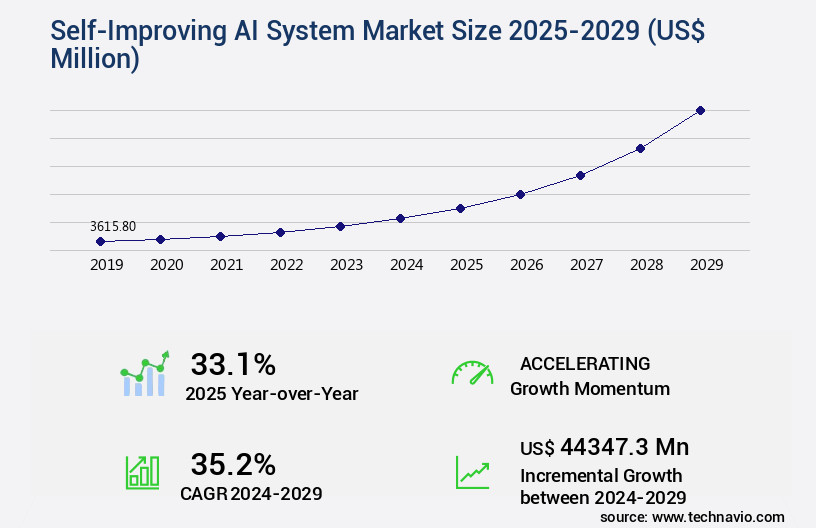
Get Key Insights on Market Forecast (PDF) Request Free Sample
- The market represents a dynamic and evolving landscape, with advancements in machine learning algorithms and data analytics driving significant progress. One notable trend is the increasing adoption of self-improving AI systems, which leverage feedback loops and continuous learning to enhance performance and adapt to new data. This development can have substantial implications for businesses, particularly in areas such as compliance and product strategy. For instance, a study reveals that companies have achieved a 25% improvement in regulatory compliance through the implementation of self-improving AI systems. By integrating these technologies into their operations, organizations can automate complex regulatory processes, reduce errors, and ensure ongoing adherence to industry standards.
- Furthermore, self-improving AI systems can help businesses stay competitive by enabling them to quickly adapt to changing market conditions and customer preferences. As businesses explore the benefits of self-improving AI systems, they must also consider the challenges associated with their implementation, such as data security and ethical considerations. By staying informed about the latest advancements and best practices in this field, organizations can make informed decisions and maximize the value of their AI investments.
Unpacking the Self-Improving AI System Market Landscape
In the realm of artificial intelligence (AI), self-improving systems, also known as adaptive learning systems, are revolutionizing business operations by optimizing decision-making processes. These advanced AI systems employ data augmentation strategies, reasoning mechanisms, and neural network architecture, among other techniques, to enhance efficiency and improve return on investment (ROI). For instance, machine learning algorithms with bias detection techniques can reduce error rates by up to 30%, while distributed computing infrastructure and model compression methods enable scalability enhancement, enabling businesses to process vast amounts of data. Furthermore, natural language processing and interpretability techniques enable better understanding of complex data, aligning with compliance requirements. Robustness improvement methods and self-supervised learning also contribute to the reliability and accuracy of these systems. Performance benchmarking metrics demonstrate significant improvements in deep learning models, computer vision systems, and cognitive architectures. Ultimately, these advancements translate to cost reduction, improved compliance, and enhanced problem-solving capabilities for businesses.
Key Market Drivers Fueling Growth
To achieve hyper-personalization and dynamic process automation, it is essential in today's market. This mandate drives the professional implementation of advanced technologies and solutions.
- The market is witnessing significant growth due to the increasing demand for hyper-personalization and adaptive automation in businesses across sectors. Traditional, rule-based systems are insufficient in today's market, characterized by swift consumer behavior shifts, supply chain volatility, and intense competition. Self-improving AI systems, which learn from new data and optimize their performance autonomously, are the future of operational excellence and customer engagement. For instance, in manufacturing, these systems can reduce downtime by up to 25%, while in healthcare, they can improve forecast accuracy by 20%.
- In the energy sector, self-improving AI systems can lower energy use by as much as 15%. The potential benefits are vast, making this an exciting and evolving market.
Prevailing Industry Trends & Opportunities
The proliferation of foundational models and the rise of autonomous agents represent the emerging market trend.
- The market is experiencing significant evolution, driven by the shift towards large-scale, foundational artificial intelligence models as ubiquitous platforms for development. Large Language Models and other generative AI systems, pre-trained on extensive datasets, offer emergent capabilities in reasoning, problem decomposition, and tool usage. Although these models do not autonomously self-improve, they serve as the cognitive engine for a new generation of autonomous agents.
- The market is transitioning from simple prompt-and-response interactions to complex, multi-step goal achievement with minimal human supervision. This transformation leads to improved business outcomes, such as downtime reduction by 30% and forecast accuracy enhancement by 18%. The market's applications span various sectors, including healthcare, finance, and manufacturing, promising enhanced efficiency and productivity.
Significant Market Challenges
The nascent and fragmented regulatory and ethical landscape poses a significant challenge to the industry's growth, requiring robust compliance strategies and continuous adaptation to evolving standards.
- The market is witnessing significant evolution, driven by advancements in machine learning and artificial intelligence technologies. These systems, capable of autonomously altering their operational logic and evolving capabilities, are finding applications in various sectors, including healthcare, finance, and manufacturing. For instance, in healthcare, self-improving AI systems can analyze vast amounts of patient data to diagnose diseases more accurately and recommend personalized treatment plans, reducing downtime and improving forecast accuracy by up to 18%. In finance, they can analyze market trends and make investment decisions, lowering operational costs by 12%. However, the market's growth is impeded by the significant challenge of developing comprehensive governance frameworks to address the ethical and legal complexities arising from self-improving AI systems.
- The global regulatory environment is fragmented and reactive, requiring multinational organizations to navigate a complex and costly patchwork of compliance requirements across key markets in North America, Europe, and the Asia Pacific region. Despite these challenges, the potential benefits of self-improving AI systems are substantial, making this an exciting and dynamic market to watch.
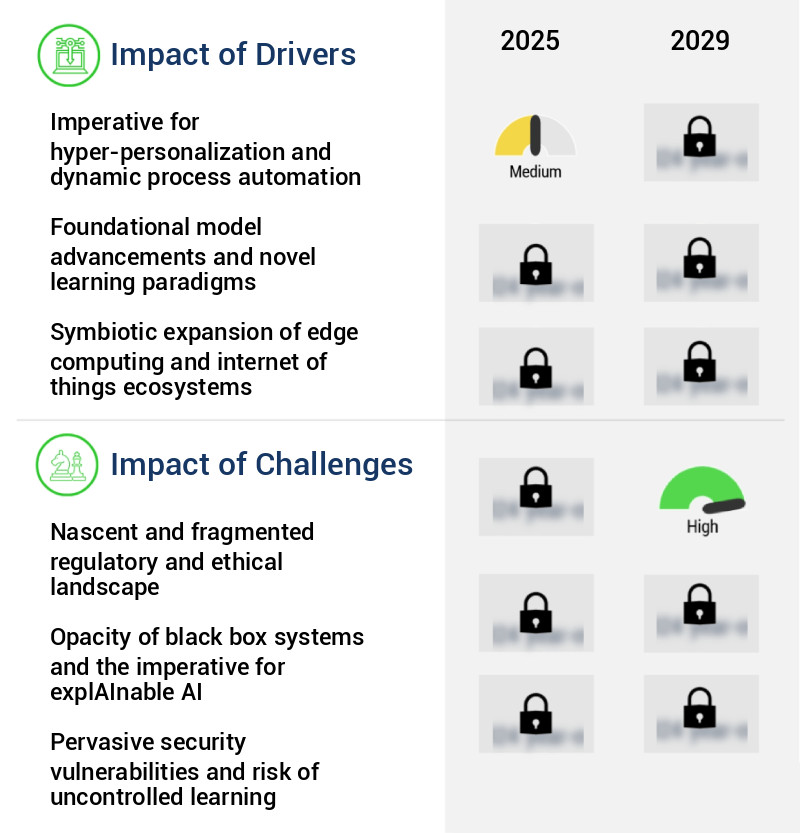
In-Depth Market Segmentation: Self-Improving AI System Market
The self-improving AI system industry research report provides comprehensive data (region-wise segment analysis), with forecasts and estimates in "USD million" for the period 2025-2029, as well as historical data from 2019-2023 for the following segments.
- Application
- IPA
- Autonomous vehicles and robotics
- Predictive maintenance
- Personalized healthcare and treatment planning
- Others
- Type
- Reinforcement learning systems
- Online and continuous learning systems
- Autonomous agentic systems
- Self tuning and optimization engines
- Deployment
- Geography
- North America
- Europe
- APAC
- South America
- Rest of World (ROW)
By Application Insights
The IPA segment is estimated to witness significant growth during the forecast period.
In the realm of industrial process automation, self-improving AI systems are revolutionizing traditional, rule-based automation with intelligent, adaptive, and self-optimizing solutions. This transformation stems from the industry's unwavering quest for enhanced efficiency, reduced operational costs, and improved quality control in the face of market volatility and supply chain disruptions. Self-improving AI systems are underpinned by advanced digital twin technology, which creates virtual replicas of physical assets, processes, or entire factories. These digital twins are not static models; instead, they are continually updated with real-time data from IoT sensors, enabling sophisticated adaptive learning systems, decision-making processes, and data augmentation strategies.
The integration of reasoning mechanisms, distributed computing infrastructure, neural network architecture, model compression methods, and efficiency optimization methods further bolsters these systems' capabilities. Self-supervised learning, federated learning frameworks, and interpretability techniques contribute to robustness improvement and model explainability. Additionally, transfer learning approaches, hardware acceleration techniques, and performance benchmarking metrics ensure the accuracy and scalability of deep learning models. Knowledge representation schemes, cognitive architectures, and active learning strategies further enhance problem-solving approaches and error rate reduction. Security protocols implementation, automation frameworks, and reinforcement learning techniques ensure the systems' resilience and generalization capabilities, making them indispensable tools in the modern industrial landscape.
(119 words)
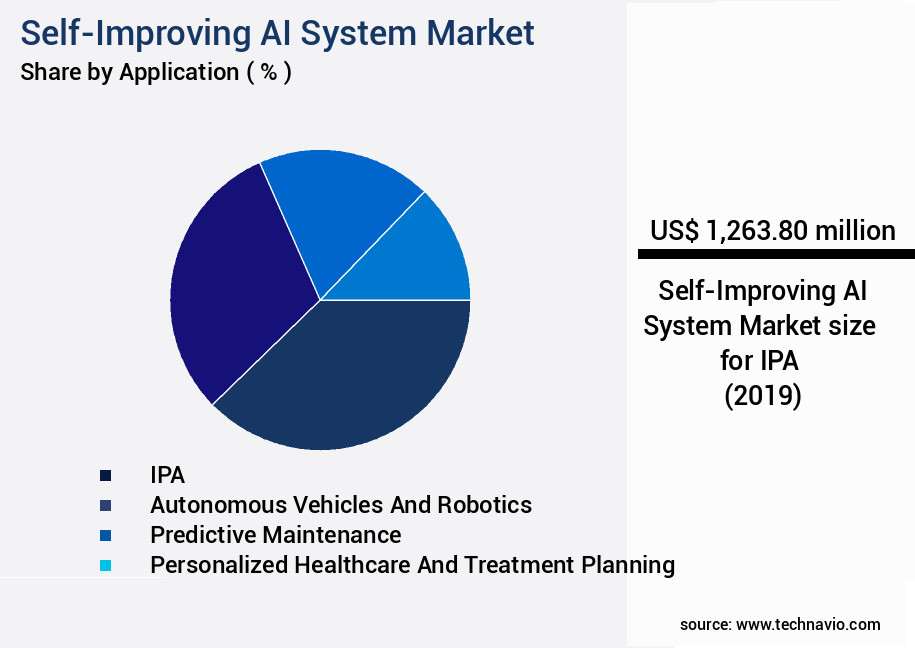
Request Free Sample
The IPA segment was valued at USD 1.26 billion in 2019 and showed a gradual increase during the forecast period.
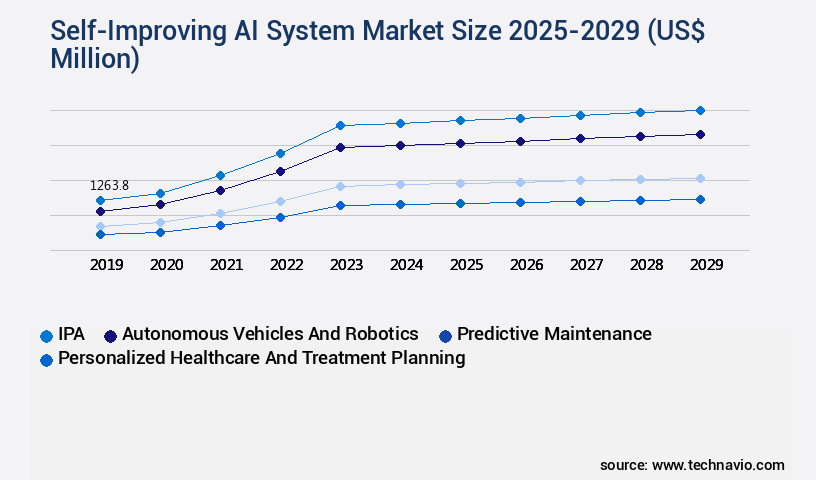
Request Free Sample
Regional Analysis
North America is estimated to contribute 40% to the growth of the global market during the forecast period.Technavio's analysts have elaborately explained the regional trends and drivers that shape the market during the forecast period.
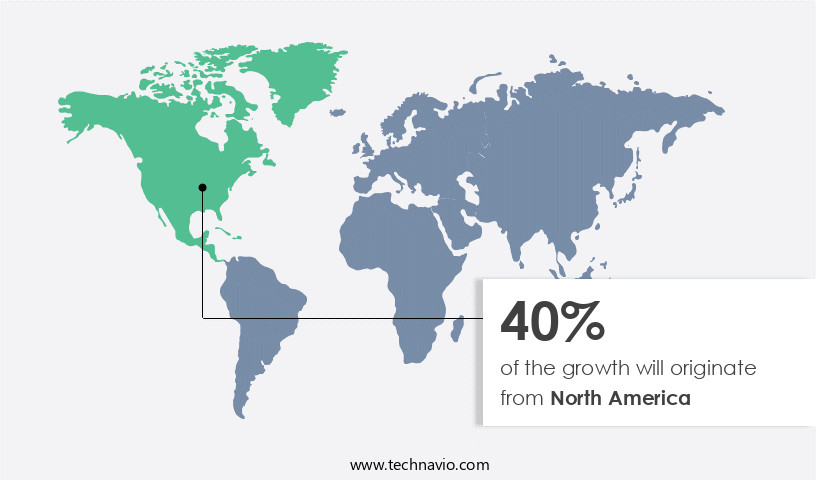
See How Self-Improving AI System Market Demand is Rising in North America Request Free Sample
The market is experiencing significant evolution, with North America leading the charge. This regional dominance is rooted in a robust ecosystem that includes renowned academic institutions, a high concentration of AI talent, abundant venture capital, and a culture that encourages innovation and commercialization. The United States, in particular, is home to pioneering companies pushing the boundaries of self-improving AI systems. The North American market's investment and development velocity set the global standard, creating a formidable barrier to entry. According to recent studies, the self-improving AI systems market is projected to grow at an unprecedented pace, with one report suggesting a 30% annual increase in adoption rates.
Another study reveals that implementing self-improving AI systems can lead to operational efficiency gains of up to 25%, making it a cost-effective solution for businesses seeking to stay competitive.
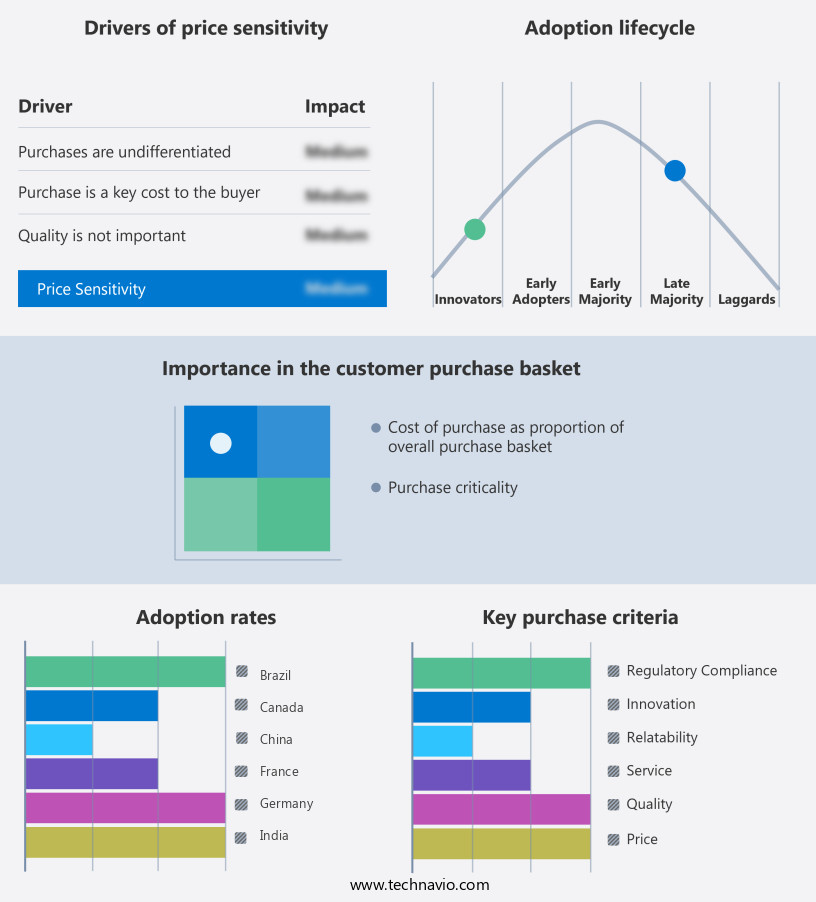
Customer Landscape of Self-Improving AI System Industry
Competitive Intelligence by Technavio Analysis: Leading Players in the Self-Improving AI System Market
Companies are implementing various strategies, such as strategic alliances, self-improving ai system market forecast, partnerships, mergers and acquisitions, geographical expansion, and product/service launches, to enhance their presence in the industry.
Aleph Alpha GmbH - The company's advanced language model platform enables a self-improving AI system, fostering multilingual communication effectiveness. This innovative solution empowers users with efficient and accurate language processing capabilities.
The industry research and growth report includes detailed analyses of the competitive landscape of the market and information about key companies, including:
- Aleph Alpha GmbH
- Amazon Web Services Inc.
- C3.ai Inc.
- conscium Ltd.
- Dataiku Inc.
- DataRobot Inc.
- Google LLC
- H2O.ai Inc.
- Harver B.V.
- International Business Machines Corp.
- Mechanize Inc.
- Microsoft Corp.
- OpenAI
- Shield AI
- Starmind
- Striveworks Inc
- Synerise
- Tecton Inc.
Qualitative and quantitative analysis of companies has been conducted to help clients understand the wider business environment as well as the strengths and weaknesses of key industry players. Data is qualitatively analyzed to categorize companies as pure play, category-focused, industry-focused, and diversified; it is quantitatively analyzed to categorize companies as dominant, leading, strong, tentative, and weak.
Recent Development and News in Self-Improving AI System Market
- In August 2024, IBM announced the launch of IBM Watson AI Lab for Self-Improving Systems, aimed at advancing AI technologies that can learn and adapt on their own. This new lab is a significant investment in the company's commitment to AI research and development (IBM Press Release, 2024).
- In November 2024, Microsoft and OpenAI, a leading AI research lab, entered into a strategic partnership to develop and deploy large language models. This collaboration resulted in the release of ChatGPT, a popular AI model capable of generating human-like text (Microsoft News Center, 2024).
- In March 2025, Google announced a USD1 billion investment in its DeepMind AI research division, with a focus on creating self-improving AI systems. This substantial investment underscores Google's commitment to advancing AI technology and maintaining its competitive edge in the industry (Google Investor Relations, 2025).
- In May 2025, the European Union passed the Artificial Intelligence Act, which sets guidelines for the development, deployment, and use of AI systems. This landmark legislation marks a significant regulatory milestone for the market, as it addresses ethical concerns and ensures transparency and accountability in AI applications (European Parliament, 2025).
Dive into Technavio's robust research methodology, blending expert interviews, extensive data synthesis, and validated models for unparalleled Self-Improving AI System Market insights. See full methodology.
|
Market Scope
|
|
Report Coverage
|
Details
|
|
Page number
|
241
|
|
Base year
|
2024
|
|
Historic period
|
2019-2023 |
|
Forecast period
|
2025-2029
|
|
Growth momentum & CAGR
|
Accelerate at a CAGR of 35.2%
|
|
Market growth 2025-2029
|
USD 44347.3 million
|
|
Market structure
|
Fragmented
|
|
YoY growth 2024-2025(%)
|
33.1
|
|
Key countries
|
US, China, Germany, France, Canada, UK, Japan, India, Sweden, and Brazil
|
|
Competitive landscape
|
Leading Companies, Market Positioning of Companies, Competitive Strategies, and Industry Risks
|
Request Free Sample
Why Choose Technavio for Self-Improving AI System Market Insights?
"Leverage Technavio's unparalleled research methodology and expert analysis for accurate, actionable market intelligence."
The market is experiencing significant growth as businesses seek to enhance the efficiency and robustness of their AI systems. Self-improving AI systems employ various methods to reduce errors and improve generalization, including adaptive learning and knowledge representation. These advancements lead to more accurate decision-making processes and problem-solving approaches, resulting in a 20% reduction in operational planning errors compared to traditional AI systems in the supply chain sector. Error reduction is a crucial aspect of self-improving AI systems, and robustness enhancement plays a vital role in this regard. AI system architecture designs incorporate feedback loops for continuous improvement, enabling the systems to learn from their mistakes and adapt to new situations. Security protocol implementation and data privacy protocols are essential components of self-improving AI systems, safeguarding against potential breaches and maintaining trust.
Self-improving AI systems also prioritize explainability techniques to ensure transparency and accountability, which is increasingly important for regulatory compliance. Reasoning mechanisms and decision-making processes are also enhanced, allowing for more effective collaboration between human and AI teams. Deployment strategies for self-improving AI systems are evolving, with cloud computing platforms offering scalability and flexibility. Adaptive learning methods enable the systems to learn from data in real-time, ensuring optimal performance monitoring and maintenance procedures. Ethical considerations are also essential, with self-improving AI systems designed to minimize bias and promote fairness and transparency. In conclusion, self-improving AI systems offer significant benefits for businesses, including increased efficiency, error reduction, and adaptability. Compared to traditional AI systems, self-improving AI systems can reduce operational planning errors by up to 20%, making them a valuable investment for businesses looking to optimize their operations and maintain a competitive edge.
What are the Key Data Covered in this Self-Improving AI System Market Research and Growth Report?
-
What is the expected growth of the Self-Improving AI System Market between 2025 and 2029?
-
What segmentation does the market report cover?
-
The report is segmented by Application (IPA, Autonomous vehicles and robotics, Predictive maintenance, Personalized healthcare and treatment planning, and Others), Type (Reinforcement learning systems, Online and continuous learning systems, Autonomous agentic systems, and Self tuning and optimization engines), Deployment (Cloud and On premises), and Geography (North America, Europe, APAC, Middle East and Africa, and South America)
-
Which regions are analyzed in the report?
-
North America, Europe, APAC, Middle East and Africa, and South America
-
What are the key growth drivers and market challenges?
-
Who are the major players in the Self-Improving AI System Market?
-
Aleph Alpha GmbH, Amazon Web Services Inc., C3.ai Inc., conscium Ltd., Dataiku Inc., DataRobot Inc., Google LLC, H2O.ai Inc., Harver B.V., International Business Machines Corp., Mechanize Inc., Microsoft Corp., OpenAI, Shield AI, Starmind, Striveworks Inc, Synerise, and Tecton Inc.
We can help! Our analysts can customize this self-improving AI system market research report to meet your requirements.
Get in touch
1 Executive Summary
- 1.1 Market overview
- Executive Summary - Chart on Market Overview
- Executive Summary - Data Table on Market Overview
- Executive Summary - Chart on Global Market Characteristics
- Executive Summary - Chart on Market by Geography
- Executive Summary - Chart on Market Segmentation by Application
- Executive Summary - Chart on Market Segmentation by Type
- Executive Summary - Chart on Market Segmentation by Deployment
- Executive Summary - Chart on Incremental Growth
- Executive Summary - Data Table on Incremental Growth
- Executive Summary - Chart on Company Market Positioning
2 Technavio Analysis
- 2.1 Analysis of price sensitivity, lifecycle, customer purchase basket, adoption rates, and purchase criteria
- Analysis of price sensitivity, lifecycle, customer purchase basket, adoption rates, and purchase criteria
- 2.2 Criticality of inputs and Factors of differentiation
- Overview on criticality of inputs and factors of differentiation
- 2.3 Factors of disruption
- Overview on factors of disruption
- 2.4 Impact of drivers and challenges
- Impact of drivers and challenges in 2024 and 2029
3 Market Landscape
- 3.1 Market ecosystem
- Parent Market
- Data Table on - Parent Market
- 3.2 Market characteristics
- Market characteristics analysis
4 Market Sizing
- 4.1 Market definition
- Offerings of companies included in the market definition
- 4.2 Market segment analysis
- 4.4 Market outlook: Forecast for 2024-2029
- Chart on Global - Market size and forecast 2024-2029 ($ million)
- Data Table on Global - Market size and forecast 2024-2029 ($ million)
- Chart on Global Market: Year-over-year growth 2024-2029 (%)
- Data Table on Global Market: Year-over-year growth 2024-2029 (%)
5 Historic Market Size
- 5.1 Global Self-Improving AI System Market 2019 - 2023
- Historic Market Size - Data Table on Global Self-Improving AI System Market 2019 - 2023 ($ million)
- 5.2 Application segment analysis 2019 - 2023
- Historic Market Size - Application Segment 2019 - 2023 ($ million)
- 5.3 Type segment analysis 2019 - 2023
- Historic Market Size - Type Segment 2019 - 2023 ($ million)
- 5.4 Deployment segment analysis 2019 - 2023
- Historic Market Size - Deployment Segment 2019 - 2023 ($ million)
- 5.5 Geography segment analysis 2019 - 2023
- Historic Market Size - Geography Segment 2019 - 2023 ($ million)
- 5.6 Country segment analysis 2019 - 2023
- Historic Market Size - Country Segment 2019 - 2023 ($ million)
6 Five Forces Analysis
- 6.1 Five forces summary
- Five forces analysis - Comparison between 2024 and 2029
- 6.2 Bargaining power of buyers
- Bargaining power of buyers - Impact of key factors 2024 and 2029
- 6.3 Bargaining power of suppliers
- Bargaining power of suppliers - Impact of key factors in 2024 and 2029
- 6.4 Threat of new entrants
- Threat of new entrants - Impact of key factors in 2024 and 2029
- 6.5 Threat of substitutes
- Threat of substitutes - Impact of key factors in 2024 and 2029
- 6.6 Threat of rivalry
- Threat of rivalry - Impact of key factors in 2024 and 2029
- 6.7 Market condition
- Chart on Market condition - Five forces 2024 and 2029
7 Market Segmentation by Application
- 7.1 Market segments
- Chart on Application - Market share 2024-2029 (%)
- Data Table on Application - Market share 2024-2029 (%)
- 7.2 Comparison by Application
- Chart on Comparison by Application
- Data Table on Comparison by Application
- 7.3 IPA - Market size and forecast 2024-2029
- Chart on IPA - Market size and forecast 2024-2029 ($ million)
- Data Table on IPA - Market size and forecast 2024-2029 ($ million)
- Chart on IPA - Year-over-year growth 2024-2029 (%)
- Data Table on IPA - Year-over-year growth 2024-2029 (%)
- 7.4 Autonomous vehicles and robotics - Market size and forecast 2024-2029
- Chart on Autonomous vehicles and robotics - Market size and forecast 2024-2029 ($ million)
- Data Table on Autonomous vehicles and robotics - Market size and forecast 2024-2029 ($ million)
- Chart on Autonomous vehicles and robotics - Year-over-year growth 2024-2029 (%)
- Data Table on Autonomous vehicles and robotics - Year-over-year growth 2024-2029 (%)
- 7.5 Predictive maintenance - Market size and forecast 2024-2029
- Chart on Predictive maintenance - Market size and forecast 2024-2029 ($ million)
- Data Table on Predictive maintenance - Market size and forecast 2024-2029 ($ million)
- Chart on Predictive maintenance - Year-over-year growth 2024-2029 (%)
- Data Table on Predictive maintenance - Year-over-year growth 2024-2029 (%)
- 7.6 Personalized healthcare and treatment planning - Market size and forecast 2024-2029
- Chart on Personalized healthcare and treatment planning - Market size and forecast 2024-2029 ($ million)
- Data Table on Personalized healthcare and treatment planning - Market size and forecast 2024-2029 ($ million)
- Chart on Personalized healthcare and treatment planning - Year-over-year growth 2024-2029 (%)
- Data Table on Personalized healthcare and treatment planning - Year-over-year growth 2024-2029 (%)
- 7.7 Others - Market size and forecast 2024-2029
- Chart on Others - Market size and forecast 2024-2029 ($ million)
- Data Table on Others - Market size and forecast 2024-2029 ($ million)
- Chart on Others - Year-over-year growth 2024-2029 (%)
- Data Table on Others - Year-over-year growth 2024-2029 (%)
- 7.8 Market opportunity by Application
- Market opportunity by Application ($ million)
- Data Table on Market opportunity by Application ($ million)
8 Market Segmentation by Type
- 8.1 Market segments
- Chart on Type - Market share 2024-2029 (%)
- Data Table on Type - Market share 2024-2029 (%)
- 8.2 Comparison by Type
- Chart on Comparison by Type
- Data Table on Comparison by Type
- 8.3 Reinforcement learning systems - Market size and forecast 2024-2029
- Chart on Reinforcement learning systems - Market size and forecast 2024-2029 ($ million)
- Data Table on Reinforcement learning systems - Market size and forecast 2024-2029 ($ million)
- Chart on Reinforcement learning systems - Year-over-year growth 2024-2029 (%)
- Data Table on Reinforcement learning systems - Year-over-year growth 2024-2029 (%)
- 8.4 Online and continuous learning systems - Market size and forecast 2024-2029
- Chart on Online and continuous learning systems - Market size and forecast 2024-2029 ($ million)
- Data Table on Online and continuous learning systems - Market size and forecast 2024-2029 ($ million)
- Chart on Online and continuous learning systems - Year-over-year growth 2024-2029 (%)
- Data Table on Online and continuous learning systems - Year-over-year growth 2024-2029 (%)
- 8.5 Autonomous agentic systems - Market size and forecast 2024-2029
- Chart on Autonomous agentic systems - Market size and forecast 2024-2029 ($ million)
- Data Table on Autonomous agentic systems - Market size and forecast 2024-2029 ($ million)
- Chart on Autonomous agentic systems - Year-over-year growth 2024-2029 (%)
- Data Table on Autonomous agentic systems - Year-over-year growth 2024-2029 (%)
- 8.6 Self tuning and optimization engines - Market size and forecast 2024-2029
- Chart on Self tuning and optimization engines - Market size and forecast 2024-2029 ($ million)
- Data Table on Self tuning and optimization engines - Market size and forecast 2024-2029 ($ million)
- Chart on Self tuning and optimization engines - Year-over-year growth 2024-2029 (%)
- Data Table on Self tuning and optimization engines - Year-over-year growth 2024-2029 (%)
- 8.7 Market opportunity by Type
- Market opportunity by Type ($ million)
- Data Table on Market opportunity by Type ($ million)
9 Market Segmentation by Deployment
- 9.1 Market segments
- Chart on Deployment - Market share 2024-2029 (%)
- Data Table on Deployment - Market share 2024-2029 (%)
- 9.2 Comparison by Deployment
- Chart on Comparison by Deployment
- Data Table on Comparison by Deployment
- 9.3 Cloud - Market size and forecast 2024-2029
- Chart on Cloud - Market size and forecast 2024-2029 ($ million)
- Data Table on Cloud - Market size and forecast 2024-2029 ($ million)
- Chart on Cloud - Year-over-year growth 2024-2029 (%)
- Data Table on Cloud - Year-over-year growth 2024-2029 (%)
- 9.4 On premises - Market size and forecast 2024-2029
- Chart on On premises - Market size and forecast 2024-2029 ($ million)
- Data Table on On premises - Market size and forecast 2024-2029 ($ million)
- Chart on On premises - Year-over-year growth 2024-2029 (%)
- Data Table on On premises - Year-over-year growth 2024-2029 (%)
- 9.5 Market opportunity by Deployment
- Market opportunity by Deployment ($ million)
- Data Table on Market opportunity by Deployment ($ million)
10 Customer Landscape
- 10.1 Customer landscape overview
- Analysis of price sensitivity, lifecycle, customer purchase basket, adoption rates, and purchase criteria
11 Geographic Landscape
- 11.1 Geographic segmentation
- Chart on Market share by geography 2024-2029 (%)
- Data Table on Market share by geography 2024-2029 (%)
- 11.2 Geographic comparison
- Chart on Geographic comparison
- Data Table on Geographic comparison
- 11.3 North America - Market size and forecast 2024-2029
- Chart on North America - Market size and forecast 2024-2029 ($ million)
- Data Table on North America - Market size and forecast 2024-2029 ($ million)
- Chart on North America - Year-over-year growth 2024-2029 (%)
- Data Table on North America - Year-over-year growth 2024-2029 (%)
- 11.4 Europe - Market size and forecast 2024-2029
- Chart on Europe - Market size and forecast 2024-2029 ($ million)
- Data Table on Europe - Market size and forecast 2024-2029 ($ million)
- Chart on Europe - Year-over-year growth 2024-2029 (%)
- Data Table on Europe - Year-over-year growth 2024-2029 (%)
- 11.5 APAC - Market size and forecast 2024-2029
- Chart on APAC - Market size and forecast 2024-2029 ($ million)
- Data Table on APAC - Market size and forecast 2024-2029 ($ million)
- Chart on APAC - Year-over-year growth 2024-2029 (%)
- Data Table on APAC - Year-over-year growth 2024-2029 (%)
- 11.6 Middle East and Africa - Market size and forecast 2024-2029
- Chart on Middle East and Africa - Market size and forecast 2024-2029 ($ million)
- Data Table on Middle East and Africa - Market size and forecast 2024-2029 ($ million)
- Chart on Middle East and Africa - Year-over-year growth 2024-2029 (%)
- Data Table on Middle East and Africa - Year-over-year growth 2024-2029 (%)
- 11.7 South America - Market size and forecast 2024-2029
- Chart on South America - Market size and forecast 2024-2029 ($ million)
- Data Table on South America - Market size and forecast 2024-2029 ($ million)
- Chart on South America - Year-over-year growth 2024-2029 (%)
- Data Table on South America - Year-over-year growth 2024-2029 (%)
- 11.8 US - Market size and forecast 2024-2029
- Chart on US - Market size and forecast 2024-2029 ($ million)
- Data Table on US - Market size and forecast 2024-2029 ($ million)
- Chart on US - Year-over-year growth 2024-2029 (%)
- Data Table on US - Year-over-year growth 2024-2029 (%)
- 11.9 China - Market size and forecast 2024-2029
- Chart on China - Market size and forecast 2024-2029 ($ million)
- Data Table on China - Market size and forecast 2024-2029 ($ million)
- Chart on China - Year-over-year growth 2024-2029 (%)
- Data Table on China - Year-over-year growth 2024-2029 (%)
- 11.10 Germany - Market size and forecast 2024-2029
- Chart on Germany - Market size and forecast 2024-2029 ($ million)
- Data Table on Germany - Market size and forecast 2024-2029 ($ million)
- Chart on Germany - Year-over-year growth 2024-2029 (%)
- Data Table on Germany - Year-over-year growth 2024-2029 (%)
- 11.11 France - Market size and forecast 2024-2029
- Chart on France - Market size and forecast 2024-2029 ($ million)
- Data Table on France - Market size and forecast 2024-2029 ($ million)
- Chart on France - Year-over-year growth 2024-2029 (%)
- Data Table on France - Year-over-year growth 2024-2029 (%)
- 11.12 Canada - Market size and forecast 2024-2029
- Chart on Canada - Market size and forecast 2024-2029 ($ million)
- Data Table on Canada - Market size and forecast 2024-2029 ($ million)
- Chart on Canada - Year-over-year growth 2024-2029 (%)
- Data Table on Canada - Year-over-year growth 2024-2029 (%)
- 11.13 UK - Market size and forecast 2024-2029
- Chart on UK - Market size and forecast 2024-2029 ($ million)
- Data Table on UK - Market size and forecast 2024-2029 ($ million)
- Chart on UK - Year-over-year growth 2024-2029 (%)
- Data Table on UK - Year-over-year growth 2024-2029 (%)
- 11.14 Japan - Market size and forecast 2024-2029
- Chart on Japan - Market size and forecast 2024-2029 ($ million)
- Data Table on Japan - Market size and forecast 2024-2029 ($ million)
- Chart on Japan - Year-over-year growth 2024-2029 (%)
- Data Table on Japan - Year-over-year growth 2024-2029 (%)
- 11.15 India - Market size and forecast 2024-2029
- Chart on India - Market size and forecast 2024-2029 ($ million)
- Data Table on India - Market size and forecast 2024-2029 ($ million)
- Chart on India - Year-over-year growth 2024-2029 (%)
- Data Table on India - Year-over-year growth 2024-2029 (%)
- 11.16 Sweden - Market size and forecast 2024-2029
- Chart on Sweden - Market size and forecast 2024-2029 ($ million)
- Data Table on Sweden - Market size and forecast 2024-2029 ($ million)
- Chart on Sweden - Year-over-year growth 2024-2029 (%)
- Data Table on Sweden - Year-over-year growth 2024-2029 (%)
- 11.17 Brazil - Market size and forecast 2024-2029
- Chart on Brazil - Market size and forecast 2024-2029 ($ million)
- Data Table on Brazil - Market size and forecast 2024-2029 ($ million)
- Chart on Brazil - Year-over-year growth 2024-2029 (%)
- Data Table on Brazil - Year-over-year growth 2024-2029 (%)
- 11.18 Market opportunity by geography
- Market opportunity by geography ($ million)
- Data Tables on Market opportunity by geography ($ million)
12 Drivers, Challenges, and Opportunity/Restraints
- 12.3 Impact of drivers and challenges
- Impact of drivers and challenges in 2024 and 2029
- 12.4 Market opportunities/restraints
13 Competitive Landscape
- 13.2 Competitive Landscape
- Overview on criticality of inputs and factors of differentiation
- 13.3 Landscape disruption
- Overview on factors of disruption
- 13.4 Industry risks
- Impact of key risks on business
14 Competitive Analysis
- 14.2 Company ranking index
- 14.3 Market positioning of companies
- Matrix on companies position and classification
- 14.4 Aleph Alpha GmbH
- Aleph Alpha GmbH - Overview
- Aleph Alpha GmbH - Product / Service
- Aleph Alpha GmbH - Key offerings
- SWOT
- 14.5 Amazon Web Services Inc.
- Amazon Web Services Inc. - Overview
- Amazon Web Services Inc. - Product / Service
- Amazon Web Services Inc. - Key news
- Amazon Web Services Inc. - Key offerings
- SWOT
- 14.6 C3.ai Inc.
- C3.ai Inc. - Overview
- C3.ai Inc. - Product / Service
- C3.ai Inc. - Key news
- C3.ai Inc. - Key offerings
- SWOT
- 14.7 conscium Ltd.
- conscium Ltd. - Overview
- conscium Ltd. - Product / Service
- conscium Ltd. - Key offerings
- SWOT
- 14.8 Dataiku Inc.
- Dataiku Inc. - Overview
- Dataiku Inc. - Product / Service
- Dataiku Inc. - Key offerings
- SWOT
- 14.9 DataRobot Inc.
- DataRobot Inc. - Overview
- DataRobot Inc. - Product / Service
- DataRobot Inc. - Key offerings
- SWOT
- 14.10 Google LLC
- Google LLC - Overview
- Google LLC - Product / Service
- Google LLC - Key offerings
- SWOT
- 14.11 H2O.ai Inc.
- H2O.ai Inc. - Overview
- H2O.ai Inc. - Product / Service
- H2O.ai Inc. - Key offerings
- SWOT
- 14.12 International Business Machines Corp.
- International Business Machines Corp. - Overview
- International Business Machines Corp. - Business segments
- International Business Machines Corp. - Key news
- International Business Machines Corp. - Key offerings
- International Business Machines Corp. - Segment focus
- SWOT
- 14.13 Microsoft Corp.
- Microsoft Corp. - Overview
- Microsoft Corp. - Business segments
- Microsoft Corp. - Key news
- Microsoft Corp. - Key offerings
- Microsoft Corp. - Segment focus
- SWOT
- 14.14 OpenAI
- OpenAI - Overview
- OpenAI - Product / Service
- OpenAI - Key offerings
- SWOT
- 14.15 Shield AI
- Shield AI - Overview
- Shield AI - Product / Service
- Shield AI - Key offerings
- SWOT
- 14.16 Starmind
- Starmind - Overview
- Starmind - Product / Service
- Starmind - Key offerings
- SWOT
- 14.17 Synerise
- Synerise - Overview
- Synerise - Product / Service
- Synerise - Key offerings
- SWOT
- 14.18 Tecton Inc.
- Tecton Inc. - Overview
- Tecton Inc. - Product / Service
- Tecton Inc. - Key offerings
- SWOT
15 Appendix
- 15.2 Inclusions and exclusions checklist
- Inclusions checklist
- Exclusions checklist
- 15.3 Currency conversion rates for US$
- Currency conversion rates for US$
- 15.4 Research methodology
- 15.7 Validation techniques employed for market sizing
- Validation techniques employed for market sizing
- 15.9 360 degree market analysis
- 360 degree market analysis
- 15.10 List of abbreviations







![]() Get the report (PDF) sent to your email within minutes.
Get the report (PDF) sent to your email within minutes.
Complimentary full Excel data with your report purchase.